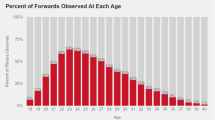Abstract
Anticipating an opponent’s serve is a salient skill in tennis: a skill that undoubtedly requires hours of deliberate study to properly hone. Awareness of one’s own serve tendencies is equally as important, and helps maintain unpredictable serve patterns that keep the returner unbalanced. This paper investigates intended serve direction with Bayesian hierarchical models applied on an extensive, and now publicly available data source of professional tennis players at Roland Garros. We find discernible differences between men’s and women’s tennis, and between individual players. General serve tendencies such as the preference of serving towards the Body on second serve and on high pressure points are revealed.







Similar content being viewed by others
Notes
Serves that were impeded by the net and have no bounce locations.
Men’s: https://www.atptour.com/en/players/ ; Women’s: https://www.wtatennis.com/players/.
For example, player-specific slow speeds versus fast speeds.
There may be some mixed strategy implications here with Djokovic seemingly more willing to randomise his serve direction options; at least, more so than Federer.
Strategy where players follow their serve immediately towards the net.
References
Albert, J., Glickman, M., Swartz, T., & Koning, R. (2017). Handbook of statistical methods and analyses in sports. CRC hand-books of modern statistical methods. Boca Raton: Chapman Hall.
Bailey, B. & McGarrity, J. (2012). The effect of pressure on mixed-strategy play in tennis: The effect of court surface on service decisions. International Journal of Business and Social Science, 3.
Carpenter, B., Gelman, A., Hoffman, M. D., Lee, D., Goodrich, B., Betancourt, M., et al. (2017). Stan: A probabilistic programming language. Journal of Statistical Software, 76, 1–32.
Cea, S., Durán, G., Guajardo, M., Sauré, D., Siebert, J., & Zamorano, G. (2020). An analytics approach to the FIFA ranking procedure and the world cup final draw. Annals of Operation Research, 286, 119–146.
Congdon, P. (2020). Bayesian hierarchical models: With applications using R (2nd ed., p. 8). Boca Raton: CRC Press.
Friesl, M., Libich, J., & Stehlík, P. (2020). Fixing Ice Hockey’s low scoring flip side? Just flip the sides. Annals of Operation Research, 292, 27–45.
Koster, J., & McElreath, R. (2017). Multinomial analysis of behavior: Statistical methods. Behavioral Ecology and Sociobiology, 71, 1–14.
Kovalchik, S. (2017). Quantifying clutch performance. Retrieved May 4, 2021 from http://on-the-t.com/2015/12/27/quantifying-clutch-performance/.
Kovalchik, S., & Reid, M. (2018). Measuring clutch performance in professional tennis. Italian Journal of Applied Statistics, 2, 255–268.
Lewandowski, D., Kurowicka, D., & Joe, H. (2009). Generating random correlation matrices based on vines and extended onion method. Journal of Multivariate Analysis, 100(9), 1989–2001.
Liu, X. (2015). Methods and applications of longitudinal data analysis. Elsevier science technology (1st ed., p. 11). Amsterdam: Elsevier.
Loffing, F., Hagemann, N., & Strauss, B. (2009). The serve in professional men’s tennis: Effects of players’ handedness. International Journal of Performance Analysis in Sport, 9, 255–274.
Morris, C. (1977). The most important points in tennis. Optimal Strategies in Sports, 5, 131–140.
Nikolaidis, Y. (2015). Building a basketball game strategy through statistical analysis of data. Annals of Operation Research, 227, 137–159.
Reid, M., Whiteside, D., & Elliott, B. (2011). Serving to different lo-cations: Set-up, toss, and racket kinematics of the professional tennis serve. Sports Biomechanics, 10, 407–414.
Rothenberg, B. (Sept. 2017). Filling a weak spot in women’s tennis: The serve. The New York Times.
Stan Development Team. (2021). Stan modeling language users guide and reference manual. Version 2, 26.
Unierzyski, P., & Wieczorek, A. (2004). Comparison of tactical solutions and game patterns in the finals of two grand slam tournaments in tennis. Science and Racket Sports, III, 200–205.
Vaverka, F., & Cernosek, M. (2013). Association between body height and serve speed in elite tennis players. Sports Biomechanics, 12, 30–37.
Vehtari, A., Gelman, A., & Gabry, J. (2017). Practical Bayesian model evaluation using leave-one-out cross-validation and WAIC. Statistics and Computing, 27, 1413–1432.
Vernon, G., Farrow, D., & Reid, M. (2018). Returning serve in tennis: A qualitative examination of the interaction of anticipatory information sources used by professional tennis players. Frontiers in Psychology, 9, 895.
Walker, M., & Wooders, J. (2001). Minimax play at Wimbledon. American Economic Review, 91, 1521–1538.
Author information
Authors and Affiliations
Corresponding author
Additional information
Publisher's Note
Springer Nature remains neutral with regard to jurisdictional claims in published maps and institutional affiliations.
Both Tea and Swartz have been partially supported by the Natural Sciences and Engineering Research Council of Canada. The Canadian Statistical Sciences Institute (CANSSI) Collaborative Research Team in Sports Analytics has also partially supported the research. The authors thank three anonymous reviewers whose comments have improved the manuscript.
Rights and permissions
About this article
Cite this article
Tea, P., Swartz, T.B. The analysis of serve decisions in tennis using Bayesian hierarchical models. Ann Oper Res 325, 633–648 (2023). https://doi.org/10.1007/s10479-021-04481-7
Accepted:
Published:
Issue Date:
DOI: https://doi.org/10.1007/s10479-021-04481-7




